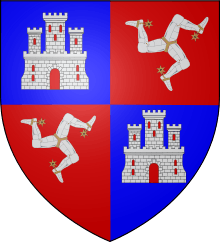Hugh Magnus MacLeod of MacLeod
Hugh Magnus MacLeod of MacLeod (born 1973) is Chief of Clan MacLeod and is currently representing the Associated Clan MacLeod Societies in the Standing Council of Scottish Chiefs.[1] He is also recognized Chief of the Name and Arms of MacLeod, in Scotland and the United Kingdom, by the Court of the Lord Lyon.
Hugh Magnus MacLeod of MacLeod | |
|---|---|
| Born | 1973 London |
| Known for | Chief of Clan MacLeod |
| Predecessor | John MacLeod of MacLeod |
On the death of his father, John MacLeod of MacLeod, on 12 February 2007, Hugh inherited Dunvegan Castle, the ancient seat of the chiefs of Macleod, and the associated ancestral clan territories, which still extend to over 42,000 acres (17,000 ha) on the Isle of Skye.
Biography
Macleod was born in London in 1973. Hugh MacLeod graduated with a BA (Hons) in Film and Modern History from the University of London and the Sorbonne in 1995.
After a brief period at Sotheby's and Freud Communications, Hugh began working in television as a researcher and was commissioned to direct/produce Champagne and Canvas, a documentary that was nominated for best video at the 1998 BBC British Short Film Festival. Since then, Hugh has worked as a freelance director, producer and writer in film and TV and now combines his media career with the management of the MacLeod Estate which he took on in 2008.
He divides his time between Dunvegan and London, where he lives with his wife Frédérique and their son Vincent.
Ancestry
| Ancestors of Hugh Magnus MacLeod of MacLeod | ||||||||||||||||||||||||||||||||||||||||||||||||||||||||||||||||||||||||||||||||||||||||||||||||||||||||||||||||||||||||||||||||||||||||||||||||||||||||||||||||||||||||||||||||||||||||||||||||||||||||||||||||||||||||||||||||||||||||||||||||||||||||||||||||||||||||||||||||||||||||||||||||||||||||||||||||||||||||||||||||||||||||||||||||||||||||||||||||||||||||||||||||||||||||||||||||||||||||||||||||||||||||||||||||||||||||||||||||||||||||||||||||||||||||||||||||||||||||||||||||||||||||||||||||||||||||||||||||||||||||||||||||||||||||||||||||||||||||||||||||||||||||||||||||||||||||||||||||
|---|---|---|---|---|---|---|---|---|---|---|---|---|---|---|---|---|---|---|---|---|---|---|---|---|---|---|---|---|---|---|---|---|---|---|---|---|---|---|---|---|---|---|---|---|---|---|---|---|---|---|---|---|---|---|---|---|---|---|---|---|---|---|---|---|---|---|---|---|---|---|---|---|---|---|---|---|---|---|---|---|---|---|---|---|---|---|---|---|---|---|---|---|---|---|---|---|---|---|---|---|---|---|---|---|---|---|---|---|---|---|---|---|---|---|---|---|---|---|---|---|---|---|---|---|---|---|---|---|---|---|---|---|---|---|---|---|---|---|---|---|---|---|---|---|---|---|---|---|---|---|---|---|---|---|---|---|---|---|---|---|---|---|---|---|---|---|---|---|---|---|---|---|---|---|---|---|---|---|---|---|---|---|---|---|---|---|---|---|---|---|---|---|---|---|---|---|---|---|---|---|---|---|---|---|---|---|---|---|---|---|---|---|---|---|---|---|---|---|---|---|---|---|---|---|---|---|---|---|---|---|---|---|---|---|---|---|---|---|---|---|---|---|---|---|---|---|---|---|---|---|---|---|---|---|---|---|---|---|---|---|---|---|---|---|---|---|---|---|---|---|---|---|---|---|---|---|---|---|---|---|---|---|---|---|---|---|---|---|---|---|---|---|---|---|---|---|---|---|---|---|---|---|---|---|---|---|---|---|---|---|---|---|---|---|---|---|---|---|---|---|---|---|---|---|---|---|---|---|---|---|---|---|---|---|---|---|---|---|---|---|---|---|---|---|---|---|---|---|---|---|---|---|---|---|---|---|---|---|---|---|---|---|---|---|---|---|---|---|---|---|---|---|---|---|---|---|---|---|---|---|---|---|---|---|---|---|---|---|---|---|---|---|---|---|---|---|---|---|---|---|---|---|---|---|---|---|---|---|---|---|---|---|---|---|---|---|---|---|---|---|---|---|---|---|---|---|---|---|---|---|---|---|---|---|---|---|---|---|---|---|---|---|---|---|---|---|---|---|---|---|---|---|---|---|---|---|---|---|---|---|---|---|---|---|---|---|---|---|---|---|---|---|---|---|---|---|---|---|---|---|---|---|---|---|---|---|---|---|---|---|---|---|---|---|---|---|---|---|---|---|---|---|---|---|---|---|---|---|---|---|---|---|---|---|---|---|---|---|---|---|---|---|---|---|---|---|---|---|---|---|---|---|---|---|---|---|---|---|---|---|---|---|---|---|---|---|---|---|---|---|---|---|---|---|---|---|---|---|---|---|---|---|---|---|---|---|---|---|---|---|---|---|---|---|---|---|---|---|---|---|---|---|---|---|---|---|---|---|---|---|---|---|
| ||||||||||||||||||||||||||||||||||||||||||||||||||||||||||||||||||||||||||||||||||||||||||||||||||||||||||||||||||||||||||||||||||||||||||||||||||||||||||||||||||||||||||||||||||||||||||||||||||||||||||||||||||||||||||||||||||||||||||||||||||||||||||||||||||||||||||||||||||||||||||||||||||||||||||||||||||||||||||||||||||||||||||||||||||||||||||||||||||||||||||||||||||||||||||||||||||||||||||||||||||||||||||||||||||||||||||||||||||||||||||||||||||||||||||||||||||||||||||||||||||||||||||||||||||||||||||||||||||||||||||||||||||||||||||||||||||||||||||||||||||||||||||||||||||||||||||||||||
Heraldry
 |
|
References
- The Standing Council of Scottish Chiefs, The Standing Council of Scottish Chiefs website - Chiefs Archived 2011-07-26 at the Wayback Machine
- Fairbairn, James (1883). Royal book of crests of Great Britain and Ireland, Dominion of Canada, India and Australasia : derived from best authorities and family records. 1. London: James MacVeigh. p. 541.
- Dewar, Peter Beauclerk (2001). Burke's landed gentry of Great Britain: together with members of the titled and non-titled contemporary establishment (19, illustrated ed.). Burke's Peerage & Gentry. pp. 941–942. ISBN 978-0-9711966-0-5.